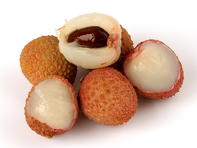The litchi or lychee as it also called (Litchi chinensis) is native to the subtropical regions of southeast China and has been cultivated there since 2000 A.D. The fruit grows in loose clusters on dense, slow-growing evergreen trees that can grow between 9 to 30 m high. Trees are round-topped and as broad as it is high.

Fruits can be strawberry-red, pink or pink-brown in colour when ripe, and oval, heart-shaped or nearly round in form. Litchi fruit is classified as drupes.
The sweet, aromatic and opaque flesh is covered in an easily peelable thin, leathery and rough skin. The litchi seed can be oval or shrivelled and ‘chicken-tongue’ shaped.
The litchi is related to the rambutan and longan, two fruit with similar-looking flesh, popular in Asia. The rambutan is covered with red and green spikes and has a creamy sweet taste while the longan (‘dragon eye fruit’) has a light brown smooth skin and a more tart taste.
Litchi Farming
China is the world's biggest producer of litchis, while South Africa is a small but important producer in the Southern Hemisphere. The South African litchi industry is built on a few cultivars focussed on a small harvesting window - from mid-October to February - which peaks in December.
Litchi trees are large and evergreen and prefer a hot moist climate with well-drained acidic soil.
It is alternate bearing fruit, meaning it produces a large crop one year and a smaller harvest the next.
Uses of Litchis
Litchi fruit is easy to peel and the seed easily slips out of the sweet, fragrant, transparent flesh. These nutritious little fruits are eaten fresh, can be juiced, made into jams, sweets and canned. However, the fruit is known to lose its aromatic flavour when canned.
Fresh litchi juice blends well with orange and lime juice but must be used immediately. To extend the shelflife of litchi juice, preservatives such as potassium meta-bisulphate can be used.
Litchi wine can be made by using the fruit pulp, fermenting it with wine yeast to produce a nutritious wine with about 11% alcohol content and a rosy aroma.
Peeled litchis can also be frozen whole, with or without the seed, to retain the natural flavour. The fruits can be frozen in syrup and will be in excellent condition for 12 months when rapidly cooled and kept at -25℃.
Dried Litchis
Litchis can be dried as well but it is done on a commercial scale in South Africa. Moisture is lost in the process, but all nutrients are retained. During this process, the skin hardens but retains its shape and colour because of the treatment with sulphur dioxide.
The sulphur dioxide also improves the porosity of the skin and improves the drying process. The flesh, however, shrivels. About 4.5 kg of fresh litchis will produce 1 kg of dried litchi. The shelflife of dried litchis is six months.
Preserving Fresh Litchis
Fresh litchi can also be preserved by soaking the peeled fruit in a 30% saline solution - retain the white film around the fruit. After an hour, remove the fruit from the solution and remove the white film. Asian cultures, particularly in Chinese philosophy, believe that removing the white film around the litchi fruit will reduce ‘fire’.
In this instance, ‘fire’ is a reference to one of the five natural elements of life. Fire indicates active energy and spiritual radiance. Additionally, ‘fire’ can also be viewed as having a fever, insomnia, headaches and thirst.
They also recommend to first eat a few bites of meat or meat soup before eating litchis to ‘reduce fire’. Another recommendation is that no more than 10 litchis should be eaten at a time.
Benefits of Litchis
Litchis are high in antioxidants, vitamin B2 (riboflavin), potassium and copper. It is estimated that seven litchis are equal to the vitamin C content of one orange and 100% of an adult’s daily recommended intake.
Litchis contain hypoglycin which can lower the blood sugar level. It can be hazardous when unripened litchis are eaten on an empty stomach. Litchis are also rich in polyphenols (antioxidants), including proanthocyanidins. These compounds may help prevent cancer and heart disease.
By Marinda Louw